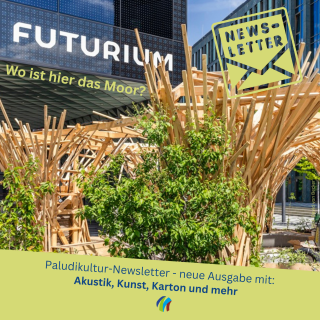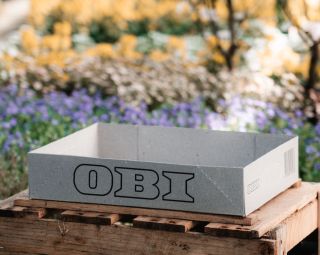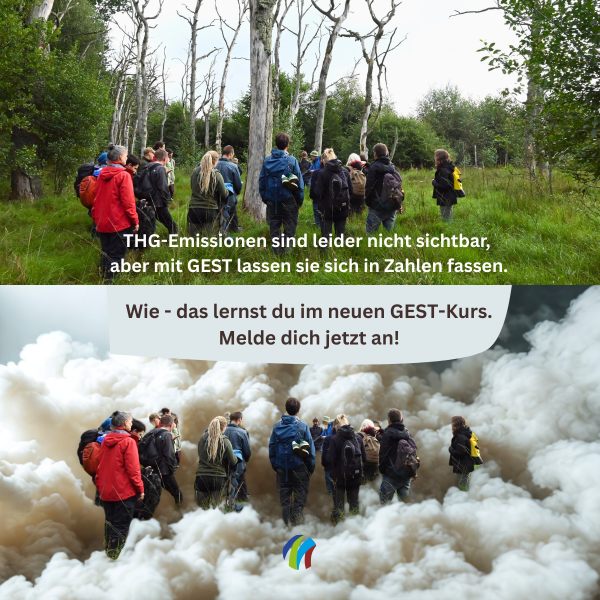News
2025
RRR2025 register now
by Helena Plochberger (comments: 0)
Preliminary programme online
03/06/2025 For the 4th conference on Renewable Resources from Wet and Rewetted Peatlands – RRR2025 from 23rd – 26th September 2025 at Greifswald, Germany, the preliminary programme is online. You can look forward to an exciting week with 2 key notes, 82 oral presentations, 66 poster, 14 workshops, 6 excursions and inspiring and surprising evening events. During the conference many workshops are offered for more room for exchange, discussion, collaboration or even training. Please register now via our registation platform, which is open until 15th August 2025! Please note that the number of participants for the conference and the workshop is limited. Stay tuned for the latest conference news on the RRR2025-website.
Acoustics, art and cardboard
by Nina Körner (comments: 0)
All in this fresh issue of our NL

23/05/2025 The current issue of the Paludiculture newsletter tells how peatland is represented in the new “Land Use” focus of the Berlin Futurium and about new courses and training programmes on peatlands. It shares news about the new cardboard box of a large German DIY store produced with a share of paludiculture biomass. In the Paludiculture interview, scientist Alexander Drexler explains why he doesn't need to hear anything himself during bioacoustic monitoring. Also: newly launched projects, new publications and an overview of current events on peatlands, climate protection and paludiculture in the calendar. We hope you enjoy reading the newsletter and would be happy to receive feedback on it by e-mail to communication@greifswaldmoor.de.
Peatland & Futurium
by Helena Plochberger (comments: 0)
Living plant installation "Superland"

22/05/2025 Just a few steps out of Berlin Central Station along the banks of the Spree and you can already see it: a living plant installation in front of the Futurium. Also integrated: Cattail and peat moss! They are intended to show that peatlands are important when it comes to land use. A joint event organised by Futurium, the Joachim Herz Foundation and the Greifwald Mire Centre on 9 October 2025 will focus on how we currently use peatlands, what problems this causes, what opportunities they offer us for the future and what conflicts there are over land use on peatland. At the Futurium's Family Day, already on 4 October 2025, we will present interesting and entertaining facts about peatlands and climate protection interactively for adults and children to participate in.
Detailed information will follow soon on the Futurium and Greifswald Mire Centre channels. Until then, just drop by if you get the chance, perhaps during a stopover at the main railway station.
Paludiculture in a garden box
by Helena Plochberger (comments: 0)
New pilot product!

25/04/2025 "Achieving mo(o)re together" - this is the motto under which OBI Group Holding, a member of the „Alliance of Pioneers“ of the toMOORow initiative, launched its first paludi pilot product in April: a plant transport box made from 10% reed canary grass. From the “field” to the OBI store, the box passes four different stations:
At the Swabian Donaumoos-Zweckverband, the reed canary grass is harvested on rewetted peatland in the Donaumoos. The company Fiber365 processes the paludiculture biomass into fibers using an innovative, environmentally friendly process. The LEIPA Group uses a mixture of these fibers, among others, to produce a cardboard base. Leopold GmBH Verpackungen then uses this to produce the actual cardboard.
This is intended for customers to transport small plant pots from the markets to their homes. In Germany alone, the DIY and garden market sells around 46 million plants every year.
See peatlands and estimate greenhouse gas emissions
by Helena Plochberger (comments: 0)
New GEST course
04/04/2025 Looking at peatlands and ... estimating greenhouse gases? Being able to do this is not a bad thing and is increasingly in demand. Recording greenhouse gases is a decisive step towards reducing them and thus combating the climate crisis. The Greifswald Mire Center not only has the right method, but also the training - the GEST course from July 2-4 in Greifswald!
GEST stands for Greenhouse gas Emission Site Type. The idea is to determine the greenhouse gases produced by water levels, land use and vegetation.
Participants will learn:
- to record water levels in the field
- to create a greenhouse gas balance sheet and determine the potential savings
The practical application takes place in two mapping exercises:
- in a degraded grassland in the Ryck lowlands and
- on the unused wet site
In addition, the following questions, among others, will be discussed:
- How can the GEST approach be classified in the climate policy framework and what other areas of application are there?
- How trustworthy are carbon certificates and what criteria are needed for them?
The course is aimed at anyone who would like to be involved in the planning or implementation of peatland and climate protection projects. There is currently a waiting list and the course fee is 370 Euro (reduced rate 220 Euro). Knowledge of botanical species is a prerequisite, previous knowledge of peatland and climate protection projects is desirable.
Register now to actively contribute to peatland and climate protection with the GEST approach!












